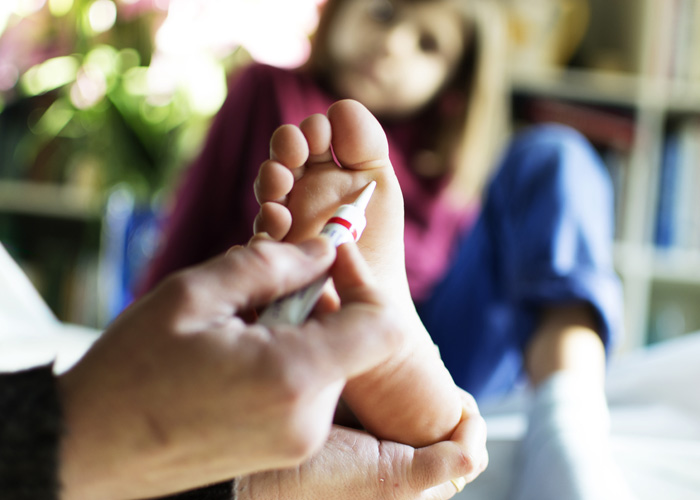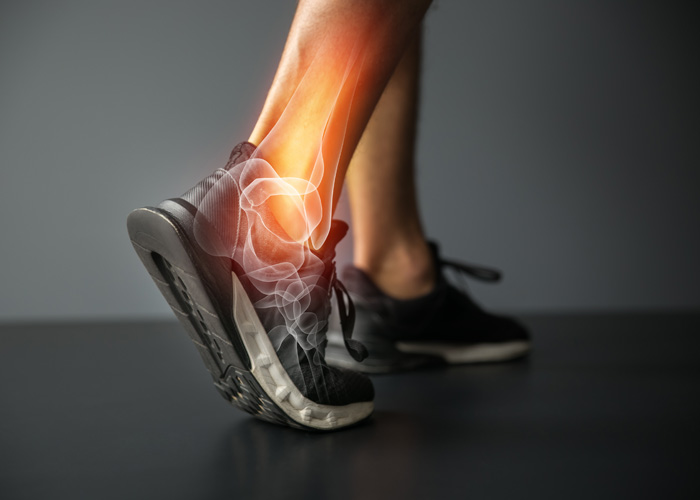Step to it
In OTC
Follow this topic
Bookmark
Record learning outcomes
As summer approaches, now is the time to educate customers on foot and leg care
National Feet Week this March, run by Osgo, the UK membership organisation for private podiatrists, urged people to prioritise their foot health in the same way they would a dental or eye appointment. Podiatrists across the UK also encouraged people not to ignore common foot ailments such as heel pain, corns, fungal nail infections and hard skin.
“There is not much that will shock a podiatrist, but we have seen some sights and most definitely conditions that could have been treated easily and effectively if they had come to us in the first place,” says Tony Gavin, CEO of Osgo. “People shouldn’t be embarrassed about having their feet checked as their health is essential for our overall wellbeing. You wouldn’t put up with a toothache or an infected eye, so why suffer in silence with often painful feet issues?”
Certain minor or mild foot ailments can often be treated within a pharmacy setting. Verrucas are particularly common in the UK and community pharmacies may be the first port of call for suitable products and self care advice. “Now that GPs are no longer treating verrucas in the surgery, patients with these common conditions are being signposted to the pharmacy for over-the-counter treatments,” says Andrew Clark, Excilor sales and marketing manager.
When visiting or using places that require you to remove your shoes and socks, bring alternative footwear that can be used to prevent foot contact with the ground
Verruca management
Verrucas (plantar warts) are found on the sole of the foot. They can spread easily and quickly and are particularly common in children. According to podiatrist Dina Gohil, Wartie ambassador and founder of DG Podiatrist in London, any public areas where people may walk barefoot are possible areas of verruca transmission. “Classic examples are swimming pools, gyms, soft play areas and showers,” she says. “Sharing shoes or socks with others can also spread the virus. When visiting or using places that require you to remove your shoes and socks, bring alternative footwear that can be used to prevent foot contact with the ground, such as swimming socks, socks with grips or even flip flops. If you are wearing socks, your feet are less likely to become contaminated.”
Verrucas are caused by viruses in the human papillomavirus family. They look like rough or dark lumps on the skin, often with a black dot in the centre, and can be painful, especially when walking. Research undertaken for the Wartie brand in 2019 revealed that 41 per cent of people have a verruca or wart at least once a year and 25 per cent of adults and 10 per cent of parents decided to not treat their or their child’s verruca or wart straight away. According to the research, 83 per cent of people said they delayed seeking treatment because they wrongly believed their wart or verruca would go away on its own. People were more likely to seek treatment if the verruca became painful or inconvenient to everyday activities, such as walking or sleeping – a constant reminder to get it treated.
According to Michael Ratcliffe, sales training manager at Cuxson Gerrard & Co, some verrucas will disappear of their own accord, but others will take months or even years. “If thewart is to be treated, it should be done straight away because the longer it is left, the harder it becomes to treat,” he says.
“Also, verrucas will respond differently to treatments, so what works with one patient may not work as well with another. Generally, the response of warts/verrucas to treatment reduces as the length of infection increases, so if the wart is troublesome cosmetically, socially or is painful, customers should start treatment early.”
Mr Ratcliffe suggests customers start with inexpensive and relatively painless products, such as plasters or self-sealing gels that contain varying strengths of salicylic acid. “Other treatments include cryotherapy, which is usually delivered as a spray that freezes the tissue and kills the virus inside,” he says. “This can be uncomfortable, but can be effective. Cryotherapy and salicylic acid have occasionally been known to cause blistering or scar tissue over the treated area. Filing the wart, and applying duct tape to the area and plantextract therapy, for example thuja and banana skin therapy, have also been reported to work in some cases.”
Pharmacy customers should be warned that it may take up to three months for verruca treatments to work and that these products can irritate the skin. Before recommending any treatments, it is important to ensure customers don’t have any underlying health issues. “People who are diabetic, pregnant or suffer from neuropathy and poor circulation-related disorders shouldn’t try to treat themselves,” says Ms Gohil. “If customers use OTC products, they should follow the instructions on the packaging. If a verruca is stubborn and doesn’t clear up with OTC products, it’s time to see a podiatrist.”

Studies have linked long periods of sitting with an increased risk of obesity, type 2 diabetes and some types of cancer
Leg health
It can be difficult for many people to get a healthy balance between sitting for much of the day (e.g. office workers) and standing for much of the day (e.g. retail workers, including the pharmacy team).
According to the Get Britain Standing campaign, British people sit for an average of 8.9 hours each day. Research shows that sitting for more than four hours a day can affect metabolism and insulin, blood pressure and blood sugar levels. Studies have linked long periods of sitting with an increased risk of obesity, type 2 diabetes and some types of cancer. Research undertaken in March 2019 at Queen’s University Belfast and Ulster University revealed that 11.6 per cent of deaths were associated with sedentary behaviour, especially sitting for six hours or more a day.
The UK Government’s chief medical officer’s physical activity guidelines recommend that adults break up long periods of inactivity with short periods of light activity. General advice from the NHS website suggests adults should:
- Stand on a train or bus, rather than sit down
- Take the stairs and walk up escalators
- Place a laptop on a box to work standing up
- Stand up or walk around while on the phone.
However, standing for long periods may also cause health problems, including aching legs and feet, puffy ankles, varicose veins and lower back pain. Research has also suggested that being on your feet all day may increase the risk of heart disease. “Standing or sitting for long periods of time can cause feet to swell and feel fatigued,” says Ms Gohil. “If customers spend most of their work day sitting, they should get up every hour and go for a short walk. Stretching and little movements can help. If they’re standing a lot, calf stretches work well and if they do get the opportunity to sit, then do it while elevating their feet. If they need extra support, they may ask their doctor or pharmacist for support stockings to help circulation.”
Mr Ratcliffe suggests that getting up from a desk and walking to perform a task is the most obvious, and best, way to tackle puffy ankles and stiff legs. “When taking the stairs, don’t run. Walk briskly instead,” he says. “This will save your knees and enable you to take one step at a time, not two or three. Stair riser heights were designed for a purpose – not to put excessive load through the knees.”
Up to 70 per cent die within five years of having an amputation and about 50 per cent die within five years of developing a diabetic foot ulcer
Michael Ratcliffe’s exercises
For office workers
- At a desk, while seated, press the feet into the ground without getting up. Do 10 repetitions at least three times a day
- Clench the buttocks for four seconds twice an hour to keep that core strong
- For legs, rock the feet on the heels, pulling up slowly and pushing down slowly over five minutes, ideally once an hour
- When getting up out of a seat, use just the thighs. Try not to use the arms to help.
For retail workers
- Rock back and forth on the heels as much as possible
- If standing still, bend the knees very slightly while standing straight and hold for four seconds, then straighten. Repeat 10 times, three times a day
- For aching feet at the end of the day, use a foot roller to relax plantar fascia (pain around the heel and arch of the foot) and ease any aching sensations in the soles of the feet.

Diabetes care
People with diabetes can be prone to foot problems, which is why they need to take extra care of their lower limbs. “High blood sugar levels can damage blood vessels, which affects how blood flows to the feet and legs,” says Dan Howarth, head of care at Diabetes UK. “Issues with circulation can therefore result in unhealed ulcers and foot infections, the leading cause of diabetes-related amputations.”
The College of Podiatry advises that all diabetes patients who are at low risk of foot ulceration should have an annual foot screen with their GP and that all those identified at their screen as having an increased risk should be offered a referral to the Foot Protection Service. All people with diabetes should be given verbal and written advice about their risk status andhow to access foot services urgently if they develop a problem.
In February 2020, Diabetes UK revealed that 27,465 diabetesrelated lower-limb amputations had been carried out over the past three years. Yet one in six hospitals still doesn’t have the specialist foot care teams, including podiatrists, doctors and nurses, needed to ensure patients receive a high quality of care.
“Foot ulcers and amputations have a devastating impact upon people’s lives, but they also increase their morbidity,” says Dr Paul Chadwick, clinical director at the College of Podiatry. “Up to 70 per cent die within five years of having an amputation and about 50 per cent die within five years of developing a diabetic foot ulcer.”
The College of Podiatry advises that people with diabetes should check their feet every day for any injuries or hard skin, as damaged skin can sometimes cause an ulcer to form. They and their healthcare team should make sure their blood glucose levels, cholesterol and blood pressure are well controlled to prevent or slow down any changes to the nerves and blood vessels that supply the legs and feet.
Mr Howarth says it’s important that people with diabetesknow what signs to look out for when checking their feet and understand what action to take. “Community pharmacistscan support people with diabetes by being aware of the tell-tale signs of foot problems, such as hard skin, a change in temperature, change in colour and cuts and sores that haven’t healed properly,” he says. “Pharmacists should also remind patients with diabetes that any problems should be checked immediately by their GP or a specialist.”
If customers with diabetes are at low risk (no affected circulation to their feet), they should be given general advice on foot hygiene and moisturisation. “Elderly patients are advised to get a carer or family member to check their feet for changes in appearance, including breaks in the skin that should be covered with a sterile dressing,” says Mike McColgan, podiatrist and part of the PelliTec development team. “That’s not to say that a low risk patient will stay low risk. As time and poor or good control move on, the risk status changes. Any changes in appearance or sensation should be referred to a GP clinic or podiatry department.”
According to a spokesperson for Dermatonics, one of the most effective strategies to prevent foot ulcers in patients with diabetes is to prevent callus formation. Patients with a call us and neuropathy are most likely to be prescribed nonkeratolytic emollients, or on rare occasions low concentration urea creams by their GP. New research into Dermatonics Once Heel Balm among patients attending diabetic foot clinics at The Whittington Hospital in London and in the Highlands has found that using an emollient with urea content helps to prevent or treat callus formation. All patients had either been prescribed standard emollients or nothing by their GPs. After using Dermatonics Once Heel Balm for two weeks, 95 per cent of patients at The Whittington no longer had a callus.
General foot advice
As summer approaches, pharmacy customers are likely to become more aware of the state and health of their feet, which may mean they are looking for extra products. Community pharmacies can advise on certain ailments, including fungal nail infections, foot odour and athlete’s foot, and should keep a range of suitable products in stock.
Excilor 2 in 1 Wart & Verruca Treatment is a double action solution that works from the inside out with a freeze treatment, and from the outside in with a gel treatment. ClearZalBAC is an antimicrobial nail solution that eliminates fungi, bacteria and viruses. It can be used with artificial nails and nail polish.
Moisturisation and exfoliation can both be important in preventing dry skin. O’Keeffe’s Healthy Feet Exfoliating Moisturising Foot Cream targets dry, hard and rough skin on the feet and removes the build-up of dry skin cells. Carnation Footcare’s Foot Mousse Intensive Rehydration contains 12.5 per cent urea to rapidly rehydrate the skin. New Flexitol Intense Overnight Foot Cream contains ingredients such as shea butter, glycolic acid and 30 per cent urea to deeply nourish hard, dry and rough skin on the feet and heal painful cracks.
Views from the P3pharmacy category panel
Sarina Mughal Day Lewis, London SW1
“This is a small category for us. We get asked quite often for flight socks, but not specifically about DVT compression hosiery. Athlete’s foot remedies and blister plasters are popular and sell well year round. Our top sellers are Scholl products and Lamisil. In summer, we have more athlete’s foot sales because people are doing more sport and it becomes more common. We are asked for blister plasters almost every day. We have a personal care area, so we display foot and leg products there. We put blister plasters near the till so customers can find them easily.”
Selina Gill Rowlands Pharmacy, Redditch
“This used to be a holiday season category, but that is changing. We generally get cosmetically driven queries about dry and cracked skin and fungal nail infections. Flexitol Heel Balm is one of our most popular treatments. As a result of the PQS foot checks for patients with diabetes, more diabetic patients are asking us for advice. Products suitable for diabetic patients to protect their feet, such as soft insoles, are great avenues to signpost customers to. Placing all leg and foot care products in a display unit has attracted passing trade. We also include travel stockings, which are popular.”
Jaimini Modi Keencare Pharmacy, Harrow
“We rarely get patients complaining of conditions of the feet or legs, so we have a small range of products. Customers who come and see us with athlete’s foot can be offered Daktarin cream or powder, which can help heal the condition. For a customer presenting with a fungal nail infection, we would recommend Amorolfine 5% nail lacquer treatment. Those presenting with pain related to the feet and legs can receive suitable analgesics, depending on the severity of the pain. This category could be grown by running a health campaign to help remove any stigma surrounding the above conditions.

